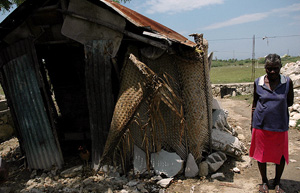
Camille Dave, 70, standing next to the shack she lives in since her house collapsed on January 12. In Sibert, a rural area located on the outskirts of Port-au-Prince, up to 70% of houses are inhabitable.
Credits: CARITAS/MathildeMagnier
By Mathilde Magnier In Port-au-Prince there are a number of neighbourhoods which aren’t considered a priority but which were hard hit by the earthquake.Caritas is working in these communities At first appearances, Sibert seems to have stood up well to Haiti’s January 12th earthquake. There’s little damage in this almost rural neighbourhood in the north of Port-au-Prince and most of the houses are still standing. But four months after the earthquake, life is harder than ever for the people living there. Despite appearances, 50 percent of Sibert’s houses are uninhabitable and 20 percent were completely destroyed. Neither completely destroyed, and yet not totally untouched, Sibert is one of the many areas in the capital where the destruction wasn’t bad enough for aid to continue. It’s a recurrent problem in the city where aid agencies concentrate their efforts on the worst effected zones, to the detriment of those not deemed a priority. However, Caritas has continued working in Sibert and has had operations there for a number of months. “The cracks in our house are too big. It’s dangerous, so we live outside in a tent that Caritas gave us,” says Wisnet Garein. “I’ve not worked since the earthquake and I no longer know how to take care of my children.” Even before the earthquake, people in Sibert had problems because of its location half way between the countryside and city. This has worsened since the disaster. “The isolation of this area is a real problem,” says Irini Klimkova, who runs the Caritas project there. “There’s no real economic activity for the people, but at the same time they don’t get the advantages that rural communities do either.” A few people such as Wisnet had jobs with firms in Port-au-Prince, but most people just manage to scrape by with their meager harvests from the patches of land they farm. But this has all changed now. The drinks manufacturer where Wisnet worked has gone, and the food people grow is barely enough to feed their families. “We used to sell peas, corn and cassava, but now we have four grown children who need feeding. We can no longer sell our produce and yet we really need the money,” says Marelise Thomas. Marelise’s house was completely destroyed in the earthquake. Until Caritas gave her a tent, she and her family lived in a hut made of mud and branches that used to be home to their goat and chickens. “In areas such as this, we have to take it step by step,” says Irina. “First we get shelter for the families, then we get rid of the debris from their houses. Then we helped the school to get up and running. In these ways we give communities the means for being autonomous again. We have to re-educate people in agriculture and business and help them feel involved. Some people are working on a cash-for-work programme nearby in which they are helping rebuild Marelise’s house. “We are the only ones to be masters of our destinies,” says one of them as they lift a breeze block onto their shoulder and head towards the house.
